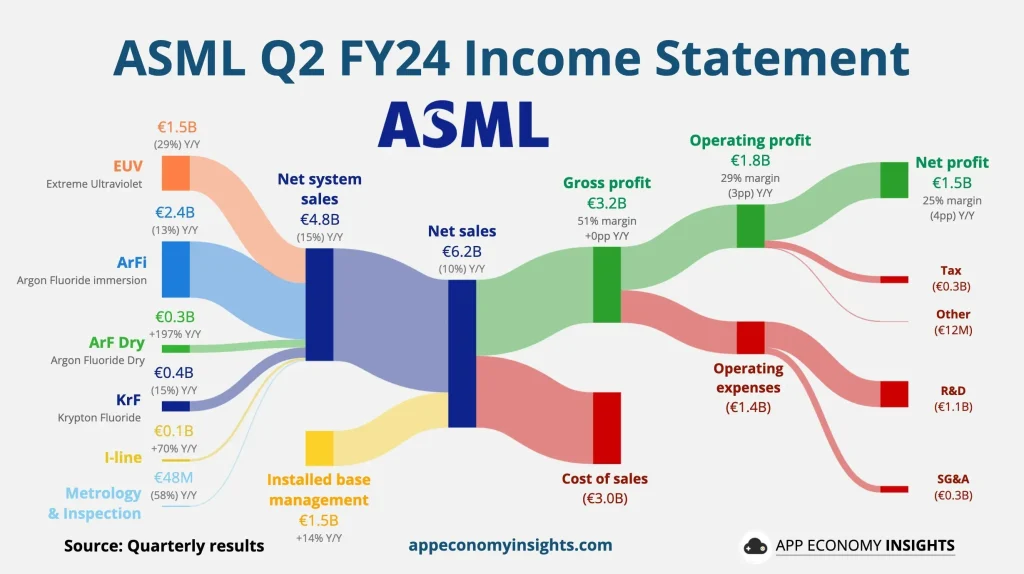ASML Q2 2025 earnings report has sparked notable interest among investors and analysts alike, showcasing a remarkable performance that exceeded expectations. The company reported net sales of 7.7 billion euros ($8.95 billion), significantly higher than the anticipated 7.52 billion euros. With a net profit of 2.29 billion euros, ASML also managed to surpass projections, however, its CFO Roger Dassen conveyed caution regarding future growth prospects amidst geopolitical uncertainties. The semiconductor industry continues to rely heavily on ASML’s advanced technologies, particularly their cutting-edge EUV lithography machines. As ASML’s net bookings reached 5.5 billion euros, indicating robust demand, the upward momentum is tempered by a revised revenue guidance that has raised questions about sustainability in the coming quarters.
The latest earnings update from ASML, known for its crucial role in the fabrication of advanced semiconductor equipment, has generated significant attention. The financial results for the second quarter of 2025 reflect a robust demand in the market, particularly noted through their impressive net sales figures. ASML’s innovations in extreme ultraviolet lithography have set the stage for growth in the tech sector; however, the company’s outlook has been met with some caution as it navigates potential economic headwinds. With net bookings exceeding expectations, there is both optimism and concern surrounding ASML’s revenue trajectories. As analysts sift through ASML’s revenue forecasts, the implications for the broader semiconductor landscape are palpable.
ASML Q2 2025 Earnings Report: A Strong Performance Amidst Challenges
ASML’s Q2 2025 earnings report showcased a remarkable performance, recording net sales of 7.7 billion euros, translating to approximately $8.95 billion. This figure significantly surpassed analysts’ expectations of around 7.52 billion euros, signaling the company’s ability to navigate through current market challenges. The robust earnings can largely be attributed to increased demand for ASML’s advanced semiconductor manufacturing equipment, particularly EUV lithography machines, which are critical for producing cutting-edge chips that power modern technology.
Despite the strong sales figures, ASML’s chief financial officer, Roger Dassen, expressed caution regarding future growth projections. He indicated that macroeconomic uncertainties and geopolitical issues could hinder the company’s ability to confirm sales growth for the upcoming years. This acknowledgment of potential risks serves as a reminder of the volatility present in the semiconductor industry, where demand fluctuations can have significant impacts on revenue trajectories.
Understanding ASML’s Revenue Guidance Adjustments
In light of the recent earnings report, ASML has adjusted its revenue guidance for the third quarter of 2025. The company now predicts revenues will range between 7.4 billion euros and 7.9 billion euros, compared to market expectations of 8.3 billion euros. Such adjustments highlight the importance of strategic forecasting in the semiconductor industry, where external factors can influence production and sales significantly. ASML’s proactive approach to revising its guidance aims to provide a clearer picture of its anticipated performance in a rapidly changing economic environment.
Furthermore, ASML’s full-year forecast for net sales has been narrowed to reflect a growth of 15%, a notable decrease from the previously estimated 30-35 billion euros. This shift underscores the need for the company to remain adaptable amidst ongoing challenges. Stakeholders will be keenly watching how ASML navigates these adjustments, especially given its critical role in the global semiconductor supply chain.
The Significance of ASML’s Net Bookings in Q2 2025
ASML’s net bookings for Q2 2025 reached an impressive 5.5 billion euros, exceeding initial predictions of 4.19 billion euros. This strong bookings performance not only reflects the sustained demand for ASML’s offerings, particularly EUV lithography systems but also indicates a broader resilience in the semiconductor market. The company’s ability to secure substantial contracts—even amidst uncertainties—highlights its pivotal role in supporting leading tech firms, such as Apple and Nvidia, in their quest for advanced chip production.
The increase in net bookings is a positive indicator for ASML, as it suggests that clients are continuing to invest in upgrading their manufacturing capabilities. This trend aligns with the growing need for more sophisticated semiconductor solutions in an era where innovations in AI and high-performance computing are becoming increasingly crucial. However, while bookings are robust, ASML must carefully manage its operations and supply chain to ensure these orders translate into revenue, particularly given the adjusted forecasts for the upcoming quarters.
Impacts of Geopolitical Issues on ASML’s Growth Prospects
Geopolitical concerns have surfaced as a significant factor affecting ASML’s growth trajectory. With uncertainties in global trade and political relations, particularly between major economies, ASML’s management has voiced caution regarding future expansion plans. CFO Roger Dassen’s warning about the inability to guarantee growth for 2026 resonates with many in the semiconductor industry, where geopolitical factors can lead to supply chain disruptions or altered customer demands.
The semiconductor industry is inherently linked with geopolitical dynamics, particularly as nations seek to secure their technological infrastructures. ASML, being a leader in the market, must strategically navigate these uncertainties, ensuring that it remains competitive while managing risks associated with global tensions. Investors and stakeholders will be closely monitoring how these geopolitical developments influence ASML’s operations and market position in the coming years.
ASML’s Position in the Evolving Semiconductor Landscape
ASML stands at the forefront of the semiconductor industry, particularly due to its innovative EUV lithography technology which is essential for manufacturing advanced chips. As industries increasingly pivot towards AI and machine learning capabilities, the demand for high-performance semiconductor solutions is on the rise. ASML’s commitment to developing next-generation EUV tools underscores its essential role in this evolving landscape, where precision and technological advancement are paramount.
However, while ASML is poised for continued growth, industry leaders recognize the need to remain agile due to external pressures. The unpredictable economic climate and evolving customer needs necessitate a flexible approach to production and innovation. ASML’s ability to adapt to these changes will be crucial for maintaining its competitive edge and further solidifying its position in this critical sector.
ASML’s Commitment to Innovation and Future Growth
With its recent advancements in EUV technology, ASML remains dedicated to driving innovation in the semiconductor space. The company is not only addressing current demands but is also preparing for future challenges in the industry. As AI continues to shape technology trajectories, ASML’s ongoing development of next-generation lithography tools will ensure that its customers can meet the increasing complexity of chip designs required to support modern applications.
ASML’s leadership acknowledges the importance of investment in research and development as a strategic priority. By fostering a culture of innovation, the company aims to stay ahead of competitors while supporting the growth of its clientele. However, this commitment to innovation must be balanced with cautious optimism regarding market fluctuations, reflecting the volatility that characterizes the semiconductor industry.
The Role of ASML in Global Semiconductor Supply Chains
As a pivotal player in the global semiconductor supply chain, ASML’s products are integral to the production of advanced microchips. Their state-of-the-art EUV lithography machines enable manufacturers to create smaller, more powerful semiconductor devices, essential for powering everything from smartphones to supercomputers. The interdependence between ASML and its clients highlights the crucial impact of their technological advancements on the broader market, driving innovation across various sectors.
The critical nature of ASML’s offerings means that any changes in their production capabilities or supply chain logistics could ripple throughout the semiconductor ecosystem. As companies increasingly rely on advanced materials and techniques, ASML must ensure that its manufacturing processes are resilient and scalable. This commitment to supporting clients and optimizing supply chains positions ASML as a leader in navigating future challenges in this dynamic industry.
ASML’s Financials: Balancing Growth and Risk
In the context of ASML’s financial health, the recent earnings report highlights a strong revenue base while also underscoring the risks and uncertainties ahead. The company’s impressive net profit figures demonstrate effective cost management and revenue generation strategies. Nevertheless, the reliance on volatile semiconductor demand necessitates a balanced approach to growth and risk management as ASML navigates evolving market conditions.
Successfully balancing these factors will allow ASML to continue its leadership in the semiconductor industry. Stakeholders will always be looking for indications that ASML can sustain its profitability while effectively adapting to market shifts. As the semiconductor landscape continues to evolve, ASML’s strategies for growth and innovation will be closely watched by analysts and investors alike.
Future Challenges for ASML Amidst Market Volatility
Navigating future challenges requires a nuanced understanding of market dynamics and potential disruptions. ASML’s management has indicated that while current earnings are solid, the volatility of the semiconductor market due to geopolitical tensions, trade relations, and technological advancements presents ongoing hurdles. The company must stay ahead of these challenges to ensure sustained growth amidst uncertainties.
Moreover, as competitors emerge and technology landscapes shift, ASML’s adaptation strategies will be vital. Building strong relationships with clients, continuing investment in R&D, and maintaining flexibility in production processes are crucial steps that ASML must focus on to mitigate risks and capitalize on new opportunities in the semiconductor sector.
Frequently Asked Questions
What are the key highlights from the ASML Q2 2025 earnings report?
The ASML Q2 2025 earnings report revealed net sales of 7.7 billion euros, surpassing analyst expectations of 7.52 billion euros. The net profit also exceeded forecasts, amounting to 2.29 billion euros compared to the anticipated 2.04 billion euros. These results reflect the company’s strong performance despite macroeconomic uncertainties affecting future growth projections.
How did ASML’s net bookings for Q2 2025 compare to expectations?
ASML reported net bookings of 5.5 billion euros for Q2 2025, exceeding market expectations of 4.19 billion euros. This strong bookings performance indicates robust demand for ASML’s EUV lithography machines and highlights the semiconductor industry’s ongoing reliance on advanced chip technologies.
What is ASML’s revenue guidance for the third quarter of 2025?
For the third quarter of 2025, ASML has adjusted its revenue guidance to between 7.4 billion euros and 7.9 billion euros, which is below market expectations of 8.3 billion euros. This adjustment reflects ongoing macroeconomic challenges and uncertainties in the semiconductor industry.
What factors might impact ASML’s growth prospects in 2026?
ASML’s CFO Roger Dassen indicated that future growth is uncertain due to macroeconomic factors and geopolitical issues. While the company remains optimistic about current demand from clients in the semiconductor industry, specific sales growth predictions for 2026 cannot be confirmed at this time.
What role does ASML play in the semiconductor industry with respect to EUV lithography?
ASML is a critical player in the semiconductor supply chain, manufacturing extreme ultraviolet (EUV) lithography machines that are vital for producing advanced chips. Their technology enables clients such as Apple and Nvidia to meet the increasing demands for higher performance chips. ASML continues to innovate in this field to support future industry growth.
How does ASML’s 2025 earnings report affect their long-term projections?
Despite strong performance in their Q2 2025 earnings report, ASML has narrowed its full-year forecast for net sales growth in 2025 to 15%, down from the initial forecast of 30-35 billion euros. This adjustment underscores the company’s cautious optimism regarding long-term growth amid an uncertain economic climate.
What are the implications of ASML’s Q2 2025 performance for investors?
Investors should take note of ASML’s solid Q2 2025 performance, with revenue and profit exceeding expectations. However, the adjusted revenue guidance and concerns about future growth in 2026 could create volatility. Investors may want to closely watch ASML’s bookings and industry demand, particularly in the semiconductor sector, to gauge future performance.
What innovations is ASML pursuing in EUV technology for the future?
ASML continues to invest in developing next-generation EUV lithography tools, which are crucial for the advancement of semiconductor technology. These innovations aim to improve chip manufacturing processes and enhance the capabilities of their clients, further solidifying ASML’s position in the evolving semiconductor landscape.
| Metric | Q2 2025 Result | Analyst Expectations |
|---|---|---|
| Net Sales | 7.7 billion euros ($8.95 billion) | 7.52 billion euros |
| Net Profit | 2.29 billion euros | 2.04 billion euros |
| Net Bookings | 5.5 billion euros | 4.19 billion euros |
| Q3 Revenue Guidance | 7.4 – 7.9 billion euros | 8.3 billion euros |
| Full-Year Growth Forecast | 15% | Initial forecast of 30-35 billion euros |
Summary
ASML Q2 2025 earnings demonstrated robust financial results, with net sales and net profit exceeding analyst expectations. However, despite the strong Q2 performance, the company expressed caution regarding future growth, particularly for 2026, due to macroeconomic uncertainties. The increase in net bookings further underlines ASML’s pivotal role in the semiconductor supply chain, but the adjusted revenue guidance for Q3 indicates that ASML is navigating through an unpredictable economic landscape. Moving forward, ASML will focus on developing next-generation EUV technology to ensure its position in the industry amidst these uncertainties.



